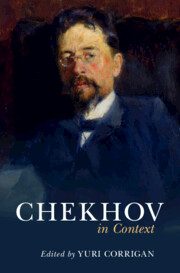Book contents
- Chekhov in Context
- Chekhov in Context
- Copyright page
- Contents
- Figures
- Contributors
- Foreword
- Note on Texts, Dates, and Transliteration
- Chronology
- Introduction
- Part I Life
- Part II Society
- Part III Culture
- Part IV Literature
- Chapter 21 Print Culture
- Chapter 22 Embarrassment
- Chapter 23 Tolstoy
- Chapter 24 French Literature
- Chapter 25 Modernism and Symbolism
- Chapter 26 Theatrical Traditions
- Chapter 27 Modern Theater
- Chapter 28 Chekhov’s Moscow Art Theater (1897–1904)
- Part V Afterlives
- Notes
- Further Reading
- Index
Chapter 27 - Modern Theater
Resonances and Intersections
from Part IV - Literature
Published online by Cambridge University Press: 16 February 2023
- Chekhov in Context
- Chekhov in Context
- Copyright page
- Contents
- Figures
- Contributors
- Foreword
- Note on Texts, Dates, and Transliteration
- Chronology
- Introduction
- Part I Life
- Part II Society
- Part III Culture
- Part IV Literature
- Chapter 21 Print Culture
- Chapter 22 Embarrassment
- Chapter 23 Tolstoy
- Chapter 24 French Literature
- Chapter 25 Modernism and Symbolism
- Chapter 26 Theatrical Traditions
- Chapter 27 Modern Theater
- Chapter 28 Chekhov’s Moscow Art Theater (1897–1904)
- Part V Afterlives
- Notes
- Further Reading
- Index
Summary
Julia Listengarten assesses Chekhov’s theatrical revolution in the context of other major innovators of his time, including Ibsen, Strindberg, and Maeterlinck, presenting Chekhov not as an exponent of any movement but as a unique theatrical practitioner whose work resonated within a broader cultural moment.
- Type
- Chapter
- Information
- Chekhov in Context , pp. 205 - 211Publisher: Cambridge University PressPrint publication year: 2023

